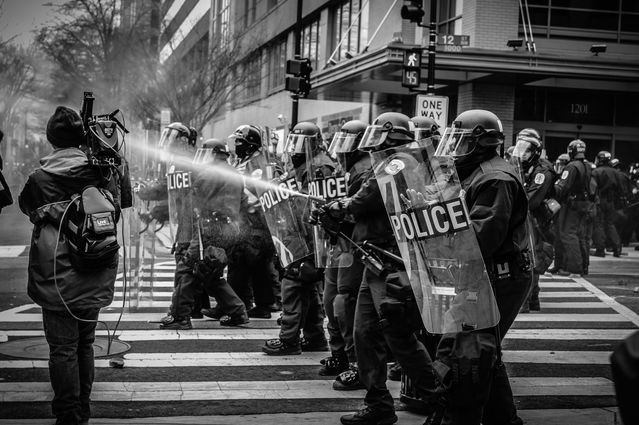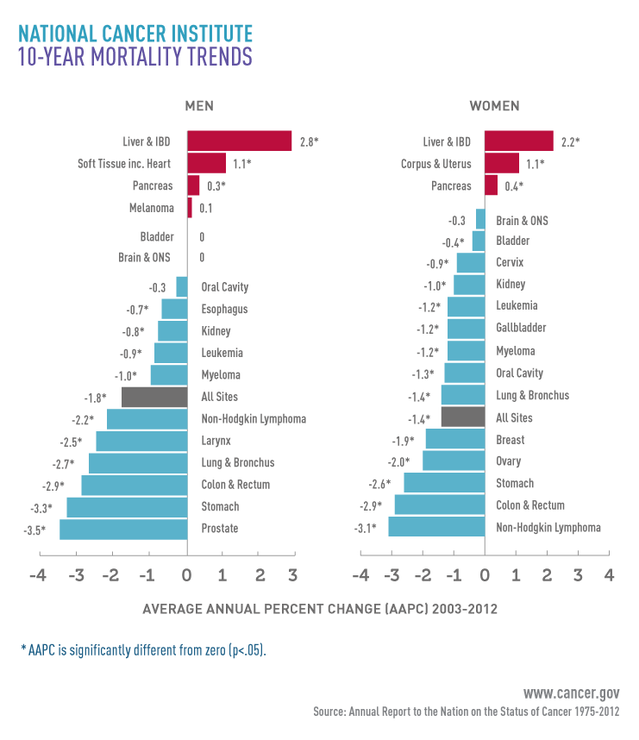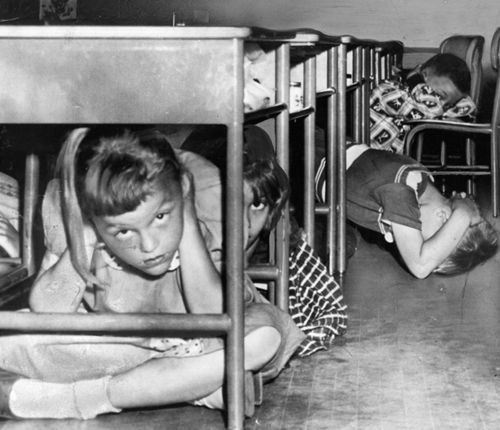Bias
Declinism: Why You Think America is in Crisis
Declinism: Belief, often due to cognitive bias, that society is in decline
Posted February 18, 2017
According to prevailing wisdom, America is on the brink of disaster. No matter where you look, things are bad, and getting worse. According to an ABC News poll taken right before the presidential election, two-thirds of the American electorate feel pessimistic about the future, and nostalgic for the past. By all accounts things are even worse now.
Google-search the phrase “America is getting worse,” and you’ll get almost 80 million results; pages upon pages of articles dissecting every aspect of life in our country. The conclusion of many: Not only are we in rapid decline, but the negatives are either “unprecedented,” or at the least we are “worse off” than at any time in the recent past. If you agree, you might find yourself feeling increasingly pessimistic, even depressed, and why wouldn’t you be?
There’s just one problem: The premise is completely false. Oh sure, you can find discrete data points to support the argument that there are specific aspects of daily life in America that are measurably “worse” than they were at specific times in our past, but overall, things are better for Americans today than ever before.

Let’s take a stroll down Memory(hole) Lane.
Declinism is the belief, often due to cognitive bias, that a society or institution is trending towards decline or failure and right now that belief is widespread. Articles with titles like “America is Circling the Drain…” and “America is doomed…” abound, and only 6% of the population thinks things are “getting better.” But to believe we are a nation in decline, you have to ignore a lot of history. Whether you’re considering the economy, race relations, gender equality, sexual freedom, or healthcare, the evidence simply doesn’t support the belief.
The Economy
Would it surprise you to know that today’s generation, the “Millennials,” are on track to be the best educated, most consistently employed in American history? It’s easy to fixate on the fact that in recent years, there’s been a drop in employment amongst 18 to 30 year-olds, but the overall employment percentage for this age group has steadily risen since the 1920s.
What about standard of living? While it’s true there’s been wage stagnation for most workers for the past several years, and that people are working differently — sometimes taking on more than one part time job, rather than a single full time job — the standard of living in the U.S. has steadily increased since the turn of the Century, and the poor in America still live better than most of the rest of humanity.
Race Relations
How far back should we go? It’s too obvious to go all the way back to slavery, but how about 1863, when Lincoln signed the Emancipation Proclamation? It seems pretty obvious things are better now than they were then, right? Fast-forward to 1963, one hundred years later, and the year many consider to be the defining year of the Civil Rights movement. Not only had we recovered from a brutal Civil War, fought primarily to free human beings from slavery (in itself a mark of progress), we had a thriving black middle-class. Martin Luther King attracted a crowd of a quarter million people for his “I Have a Dream” speech on the steps of the nation’s Capitol, and the following year, we passed the Civil Rights Act.
Obviously race relations have not improved in a perfectly straight upward line. MLK and Malcolm X were assassinated, and there were riots frequently during those years, but since then the overall trend has been positive, towards more freedom and representation for blacks in all areas of American life, not less. Some will point to the protests in Ferguson Missouri, and on the streets of other American cities recently but compared to LA during the Rodney King riots or race riots in the 60s these are absolutley mild by comparison. It would be a fallacy to look at the history of race relations in America, and conclude that things are worse now than they were in the past.
Gender Equality
In 1863, women didn’t have any more right to vote than black Americans, and they didn’t get it until 1920. What about 1963, how were women doing then compared to now? Well, for starters, they weren’t allowed to lawfully open their own bank accounts or have their own credit cards. Getting pregnant was a fireable offense, and if a woman wanted to remain single, she was considered “immoral,” “neurotic,” or “sick.”
Access to birth control has improved dramatically since the 1960s as well. In 1960, the FDA approved the birth control pill, but it wasn't until the landmark Supreme Court decision, Eisenstadt v. Baird in 1972, that unmarried women were allowed to use it. That decision set the precedent for the Roe v. Wade decision in 1973, which legalized abortion through the first trimester in all states.
With more autonomy over their fertility, women can now remain single for life without shame or shunning, and they can choose a wide range of career paths their grandmothers wouldn’t have dared pursue. People might debate the merits of their individual choices, but if we’re comparing past to present, in the area of gender equality, women are more equal to men now than they’ve ever been.
LGBT Rights
Members of the LGBT community have scored major victories in recent years in their fight for equality. Compared to the 1960s, when all homosexuals were considered “mentally ill,” LGBT Americans today are serving in the military, and getting married, legally. A full 57% of Americans support gay marriage, and an equally high percentage accept homosexual relationships as “normal”.
There are laws on the books now preventing discrimination against LGBT Americans in the workplace, and in housing, and there are openly LGBT elected officials, athletes, and entertainers. Considering most of these things would have been unthinkable just a decade ago, never mind in the 1960s, it’s clear that in this area of American life, we are not going backwards.
Healthcare
Talk to your average American these days about healthcare, and you’re likely to hear nothing but negative comments. They’ll probably tell you costs are higher, wait times are longer, and treatment quality is spottier than they remember it.
They aren’t wrong about that in many cases, and there are problems to be addressed, but in the terms of treatments and cures for a wide variety of diseases we have never had it better.
If we look at cancer, for example, the only thing in decline is the mortality rate for most types. Despite the higher costs and frustration of longer wait times, mortality rates for people with these cancers have declined every year for ten years running. Most importantly the average life expectancy for Americans has also improved dramatically. In 1960 it was 69.7. Today, it’s at an all-time high of 78.8.

There may be problems with the delivery system, and the way we pay for healthcare, but the care itself, the scientific advancements in understanding and prevention, especially for rare and chronic diseases and conditions, has never been better. In my own field of neuroscience, the advancements have been astounding.
The bottom line is this: In the most hotly debated areas of American life, we have seen steady improvement over the past Century at least, and perceptions aside, not only are we are not in decline, we are thriving
No, we are not worse off than we were in the 1960s.
When people talk about times being the "worst ever", or "getting worse,” they have to be using some other period of time as their frame of reference, right? So, let’s look at some bad times from the past, and quickly compare the state of the nation then to now. For those people still alive today, the first really “bad” time they can probably remember is the Great Depression. With an unemployment rate hovering around 25%, and the entire world on the brink of a second World War in the 1930s, it’s nearly impossible to think we are worse off today than we were then!
Fast forward to my own childhood, in the 1960s. When I was in 1st grade, we did “duck and cover” drills because the Gulf Coast was in range of Cuba’s nuclear missiles. Every day, the siren would sound, and we would huddle under our desks, like that was going to protect us from a nuclear bomb. Are kids today being trained to protect themselves from a nuclear holocaust? No.

Some people who argue we're worse off today than we were in the ‘60s point to the recent riots, both by supporters of the Black Lives Matter (BLM) movement, and by protesters at UC Berkeley, as evidence, but their perceptions don’t match the facts. In the ten years from 1963 - 1973, there were multiple large-scale race riots every year. When students protested at Kent State in Ohio, in 1970, National Guardsmen shot and killed four of them. When the students rioted at Berkley two weeks ago, as bad as the property damage was, no one died.
Others point to the way our country is polarized politically. Some even claim that President Trump is the “most disliked president ever” but the fact is, that still remains to be seen. Donald Trump may be starting his term with lower approval ratings than Richard Nixon, but he’s nowhere near the rock-bottom levels Nixon hit at the time of his resignation. It’s early yet, and time will tell, but it’s also important to remember that Nixon didn’t face 24/7 news coverage, and not just by legacy networks, but also cable channels, Internet bloggers, commentators, the foreign press (now conveniently translated into English, automagically), and anyone and everyone with an Internet connection on social media platforms like Twitter and Facebook.
It’s important to remember this last point about media proliferation, and technological advancements since the ‘60s because both amplify the effect of factors that influence our perception of the world around us.
So, if things aren’t worse, why do we feel like they are?
Human beings think about the past, present, and future subjectively. No matter how hard we strive for objectivity, or insist we’re only considering the “facts,” we’re probably not. This isn’t a character flaw, it’s the way our brains work. Here are some well recognized psychological theories that will help explain how our mind actually tricks us into thinking things are worse than they are.
The Reminiscence Bump
This is the tendency for older adults to have more vivid memories, and nostalgia for events that occurred during their adolescence and early adulthood. There are several theories that attempt to explain the reason for this bump, but the key takeaway is that we simply remember events from this period of our lives in much greater detail and with more fondness than the memories from other times in our lives. After all when you think back to times when you were young, vibrant and healthy the whole world seemed to be a better place.
In addition, technically millennials can also have a reminiscence bump with their school years being perceived more positively since they were still on mom and dad’s nickel.
The Positivity Effect
This goes hand in hand with the reminiscence bump. As we age, the brain has a preference not only for remembering positive over negative stimuli, but also for accentuating positive, and minimizing negative memories. Therefore, if we are wired to reminisce about the past and accentuate the positive from those memories is it any wonder that today seems so much worse than yesterday?
The question as to why we are wired this way falls into the realm of evolutionary psychology which I will be discussing in a future blog. For now, the easy explanation is that as we get older it’s more pleasant to focus on the positive and minimize the negative and my theory is that this is a selective defense mechanism to protect against depression.
The Negativity Bias
Whereas the positivity effect and reminiscence bump deal with memories, the negativity bias deals with the here and now. In order to keep us alive long enough to pass on our genes, our brains evolved with a bias towards overestimating current threats, and underestimating opportunities and resources. Simply put, we humans give more weight to the “bad” stuff than we do to the “good” stuff that happens around us.
Some researchers suggest the ratio is as high as 3:1 negative to positive. Classic studies have looked at gamblers or those in the stock market who either won or lost money and the pain of losing is vastly greater than the joy of winning. In a prehistoric world with potential danger around every corner this trait was paramount for survival. Again, it’s crucial to understand that traditionally this has nothing to do with memory rather it is an ongoing threat assessment of the present time based on how we are wired.
The negativity bias probably accounts for most of our perception that things are worse than they are at any given time, but especially right now in America. We’re already predisposed to notice three negative things for every one positive, but then add in the negative information coming at us from sources that want us to be afraid, or to think things are bad and only getting worse. Politicians who need our votes, companies that want to sell us products, pundits who want to sway our opinions, all work hard to capitalize on the negativity bias, because it works.
The negativity bias is one reason we tend to ignore positive facts, or quickly dismiss them, in favor of negative messages, even when the negative messages fail to refute the positive facts! The result? The sense that something is still very wrong, even when it may not be.
Of all the recognized psychological factors that influence our perceptions and beliefs, confirmation bias is the most important to understand because it’s the one most likely to negatively impact our decision making, and it's the one we can take steps to overcome.
Confirmation bias is when we have a preset world view and then seek to find facts to support that view.Therefore, confirmation bias isn’t limited to rejecting positive facts, sometimes it causes us to reject negative information too. What matters most is what we want the truth to be. We reject anything that casts doubt on what we already believe, and readily accept anything that confirms it. It’s easy to see why another name for confirmation bias is “wishful thinking.”
Confirmation bias feeds the perception that things are getting worse in America too, but it does this differently for different groups of people. For people who support the current administration, who are inclined to reject information from the constant barrage of negative press about it, the very fact that there’s so much they have to reject may makes them feel that things are getting “worse”. They’ll often comment on how the previous administration didn’t have to deal with so much negativity, and will quickly reject evidence to the contrary.
Conversely, people who oppose the administration not only immediately believe all the negative press, the sheer volume of it makes them feel like things are dire, and getting worse by the day.
Confirmation bias is powerful. It requires conscious effort to overcome, and people are often socially motivated to avoid making the effort. For example, if you’ve chosen your friends based on shared beliefs, you’re unlikely to go looking for information that contradicts those beliefs because doing so might put you at odds with your friends. But that’s what you would have to do to ensure you were accurately assessing a situation, and not just giving in to confirmation bias.
When we understand our brains, we can change our minds.
Today, overcoming confirmation bias is harder than ever. With social media, we have the power to personalize our social interactions. We can self-select “like-minded” people to the exclusion of those who disagree, or who might disagree, and we can filter, or even block, people, and sources of information that challenge or contradict our opinions and beliefs.
Thanks to cable and Internet news, the onslaught of information is growing exponentially faster and more affordable, and we have the ability to choose from hundreds, if not thousands, of news outlets. Thanks to advanced search filtering technologies, we can, and generally do, choose our news sources specifically because their stories tend to confirm what we already believe.
If we don't consciously fight this urge to personalize and customize, we end up creating our very own echo-chamber, where we never have to check our premises, and we tend to confuse our own self selected perception with reality.
Making matters more difficult, is the fact that purveyors of news and opinion understand how our brains work. They know perfectly well we're looking for confirmation bias, and they use that to their advantage. First, they answer our demand with a 24/7 supply. Second, they use our desire for validation in combination with negativity bias. They tell stories that highlight the negative to capture our attention, then they confirm our bias to make us feel like we're in the right place. Lather, rinse, repeat…Voila! Loyal audience.
We truly are living in a brave new world whose foundation is based on information that is presented at the speed of light by a multitude of sources with a variety of motives. The savvy players: politicians, news outlets, Madison Avenue advertisers, Wall Street and wannabe revolutionaries all realize the power of this information and how to use it to their advantage. They understand the psychology of this better than a neuroscientist. The only protection we have is critical thinking. With this in mind ponder the question, are things really that bad?
Join me on Facebook
More blogs related to this topic:
References




